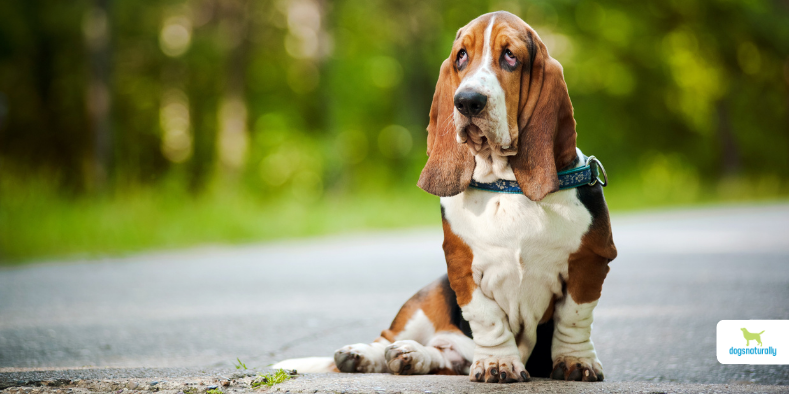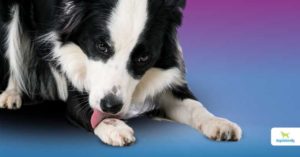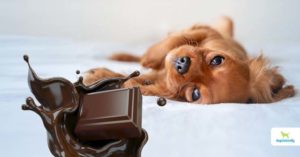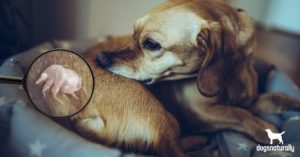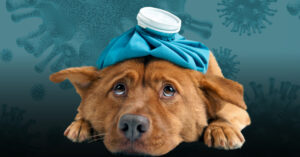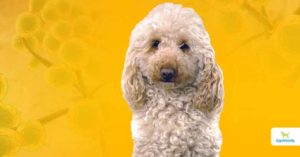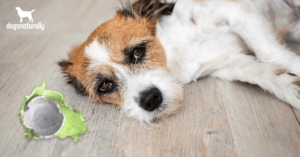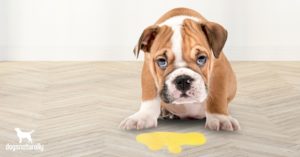If you have a wrinkly-faced or squishy-faced dog breed, you need to know about entropion. Entropion is an eye condition that’s more common in these breeds. And it can be quite uncomfortable or even painful for your dog.
So it’s important to recognize entropion quickly and take steps to resolve it. Most vets will tell you it can only be cured with surgery … but as I’ll explain later, that’s not always true.
What Is Entropion?
Entropion is an ingrowing eyelid. If your dog’s eyelid is inverted or turned inwards, towards the eyeball, that’s entropion. It’s often quite uncomfortable, because it makes the eyelashes rub on the cornea. And over time, it can cause corneal scarring or ulceration.
RELATED: The eyes are a window to your dog’s health …
Forms Of Entropion
There are 3 kinds of entropion:
Genetic (Inherited) Entropion
This is the most common kind of entropion.
It happens most often in breeds with wrinkly skin or droopy eyes … like Shar-peis or Bloodhounds. Brachycephalic breeds like Pugs or Bulldogs are also prone to entropion. But many other breeds, from Bull Terriers to Spaniels or Golden Retrievers can also get it.
Genetic entropion often starts at birth.
Acquired Entropion
This stems from changes in the eye globe or surrounding muscles that let the eyelid turn inwards.
Spastic Entropion
This is usually temporary. It can be caused by an inflammatory eye condition … like a corneal ulcer, uveitis or conjunctivitis. The inflammation and contraction from these conditions can cause the lids to turn in.
Symptoms Of Entropion
You might suspect your dog has entropion if you see some of these signs:
• Watery, tearing, irritated eyes
• Pawing or rubbing the eye
• Squinting
Entropion can happen to one or both eyes. And it can affect the upper or lower lids or both.
Some dogs with mild entropion don’t show symptoms and aren’t in any discomfort. In more advanced cases, your dog may have corneal scarring or pigmentation changes.
Sometimes entropion can be hard to recognize. Homeopathic veterinarian Richard Pitcairn DVM PhD offers this tip to check for entropion.
• Gently pull lids away from eye and let them fall back.
• Repeat several times.
• If the eyelids are ingrown, you should be able to see the cuffing in of the lids as you release them.
PRO TIP
There’s a condition called ectopic celia that has similar symptoms to entropion. It’s when hair grows on the inside of the eyelid. It’s uncommon, but if it happens, your dog will be squinting or holding her eye shut. As you can imagine, it’s very uncomfortable.
If you’re not sure about entropion (or ectopic celia), ask your vet to do a visual exam to confirm it.
Managing Entropion
I mentioned there are 3 different types of entropion. Treatment varies depending on which your dog has. Let’s tackle the simplest one first … spastic entropion.
Spastic Entropion
This condition will usually resolve once the underlying cause is treated. For example, once the pain of a corneal ulcer is relieved, the entropion should ease as well.
You may need to ask your vet to help you identify what’s causing the entropion.
But before deciding on treatment … it’s a great idea to consult a veterinary homeopath about your dog’s diagnosis. A skilled homeopath can often help you resolve eye issues. These include mild corneal ulcers, conjunctivitis, or trauma due to a scratch or blow to the eye.
For example, homeopath Christopher Day MA VetMB VetFFHom MRCVS says the remedy Natrum muriaticum can help with gross conjunctivitis with blepharospasm (eyelid twitching).
And when eyelid inflammation causes swelling leading to entropion … Tellurium is a useful remedy.
In some cases, though, your dog may need conventional veterinary treatment for an eye problem.
If treating the underlying eye ailment doesn’t resolve it, conventional vets may offer other options for spastic entropion.
- Everting the eyelashes away from the eye, with mattress sutures in the lid.
- Subcutaneous injections (usually of procaine penicillin) into the eyelid.
- Palpebral (eyelid) nerve blocks as a way to anesthetize pain.
But again, talk to a veterinary homeopath before you make a decision. It’s always worth trying to avoid surgery or conventional drugs when you can.
RELATED: Why are my dog’s eyes red …
Acquired Entropion
Treatment will also depend on the underlying condition. For example, one cause might be end-stage glaucoma where the eyeball has shrunk. That will be hard to resolve.
But once again … I’d suggest you contact a homeopath first. Homeopathy can often help with glaucoma or other eye conditions.
Conventional Approach To Genetic Entropion
This is the most common type of entropion. And as the name suggests, puppies may be born with the condition. Most vets will tell you that surgery is the only solution.
Full entropion surgery is usually done on dogs over 6 months of age. The most common surgery is called Hotz-Celsus surgery or blepharoplasty. It shouldn’t be done until your dog’s head conformation is fully developed.
Different head types need different types of surgery. Brachycephalic breeds need a different approach than dogs with very droopy eyes. So do very wrinkly dogs.
So be sure to consult with a veterinary eye specialist with experience in the various procedures. And ask her to tell you the success and failure rates of the surgery she’s recommending. Not all surgeries have good success rates.
In younger puppies, your conventional vet may suggest “tacking” the eyelids for 2 to 4 weeks. As your puppy grows, the tacking may need to be repeated. This is less extreme than full surgery.
But there are more natural ways to approach entropion in a puppy. And they could help you avoid surgery!
RELATED: 5 tips for raising a puppy …
Managing Entropion Naturally
1. Manual “Rolling”
One technique that you can try at home is to “roll” your puppy’s eyelids outwards several times a day. This can help relax the muscles that are causing the eyelids to invert. The technique could help your puppy outgrow his entropion.
2. Homeopathy For Entropion
Several veterinary homeopaths have successfully resolved entropion in young dogs. That’s because it’s a malformation in your puppy’s growth … and homeopathy may help correct it. Homeopathy is much safer and cheaper than surgery! So it’s definitely worth a try before resorting to surgical treatment!
3. Avoid Conventional Treatment For Eyes
Veterinary homeopath Dr Todd Cooney discussed homeopathy for eye problems in the Innovative Veterinary Care (IVC) Journal. He agrees with human homeopathic ophthalmologist Edward Kondrot MD CCH DHt that the main cause of eye disease is suppression. Modern medicines and treatment methods (including surgeries) that suppress symptoms include …
- Antibiotics for conjunctivitis
- Treatment of chronic blepharitis
- Steroid eye drops and ointments
- Cataract surgery
- Laser surgery and injections for retinal disease
Dr Cooney wrote …
“These “opposite” treatments cause the disease to go deeper into the body, resulting in more serious eye problems. A good example is the “side effects” listed for steroid eye drops, which are actually the result of suppression – corneal ulcers, infections, cataracts, increased intraocular pressure, to name a few.”
Homeopathic Remedies For Entropion
Dr Cooney told me he’s resolved several cases of entropion in young dogs and cats with homeopathy. He and veterinary homeopath Dr Don Hamilton both recommend one of two remedies. These are Borax and Calcarea carbonica. Dr Christopher Day also finds Borax to be an effective treatment. And Dr Richard Pitcairn has successfully used Calcarea carbonica.
Here are the characteristics of these remedies.
Borax. Extreme sensitivity to noise. Fear of falling (avoids going downstairs or may panic when picked up). Animal needing this remedy may also have mouth ulcers.
Calcarea carbonica. Good for a lot of developmental problems. Patients tend to be soft and flabby and may be big boned. They may also be rather clumsy. Eye inflammation may be less than when Borax is needed.
Dosing
You can contact your homeopath for the best dosing schedule for your dog’s condition. Dr Pitcairn recommends giving 1 pellet or tablet every 12 hours, at least 10 minutes away from food. If there is no improvement after the 6 doses, change to a different remedy.
To give homeopathic remedies:
- Tip the pellet(s) straight into your dog’s mouth. Try not to touch the pellets with your hands as it can interfere with the remedy.
- Or … put the pellets into a small glass of filtered or spring water. Stir vigorously for about 30 seconds. Then use a dropper or teaspoon to place some of the liquid on your dog’s gums. Keep this liquid dose on your counter and use it for 2-3 days. Do not refrigerate. Stir before each dose.
Dr Pitcairn also advises adding drop of almond oil in the eye 3 times a day to relieve discomfort.
PRO TIP
From Dr Pitcairn. If the eyelids have become hardened through scarring, give the tissue salt Silicea 6X. Place 1 tablet on the tongue once a day for 4 weeks. If it helps, keep going as long as needed. It could be several months.
Herbs For Entropion
Alternatively, there are some herbs you can try for your dog’s entropion.
Dr Richard Pitcairn suggests goldenseal tincture or glycerin extract.
Add 3 drops to 1 cup of pure water. Add ¼ tsp sea salt. Mix well and store at room temperature.
Place 2-3 drops in the affected eye 3 times a day to stimulate healing.
Canine herbalist Rita Hogan finds so an eyewash made with Chelidonium majus is good for entropion.
Put the dried leaf in a fillable tea bag and soak in hot water. Let it cool, then use the tea bag as a compress on the eyes. It works well to relieve symptoms.
Entropion can be a painful condition for your dog. But you do have some non-surgical alternatives … and personally, I’d rather avoid surgery any time I can. Surgery should be a last resort for anybody … and especially your dog!
References
Pereira MG et al. Eyelid entropion. Semin Ophthalmol. 2010 May;25(3):52-8.
Read RA, Broun HC. Entropion correction in dogs and cats using a combination Hotz-Celsus and lateral eyelid wedge resection: results in 311 eyes. Vet Ophthalmol. 2007 Jan-Feb;10(1):6-11.
Asti M, Nardi S, Barsotti G. Surgical management of bilateral, upper and lower eyelid entropion in 27 Shar Pei dogs, using the Stades forced granulation procedure of the upper eyelid only. N Z Vet J. 2020 Mar;68(2):112-118.
Todd Cooney DVM CVH. Homeopathy for eye disorders. IVC Journal. February 2017.

